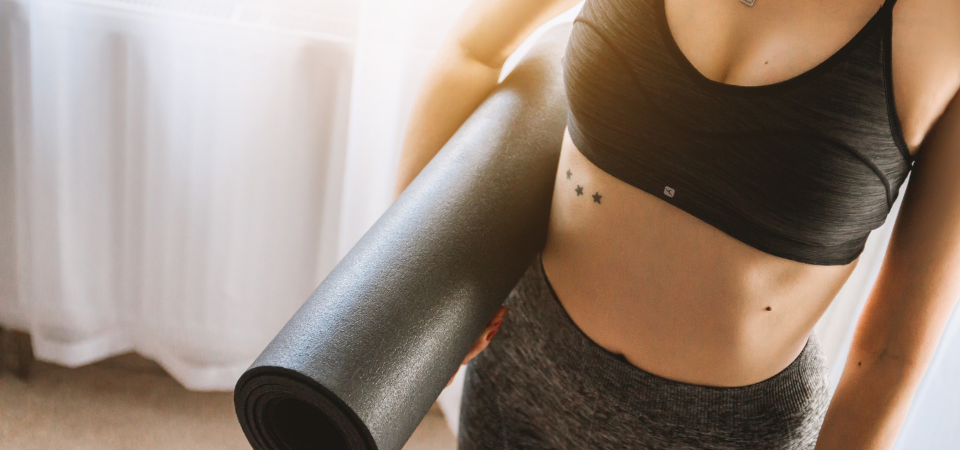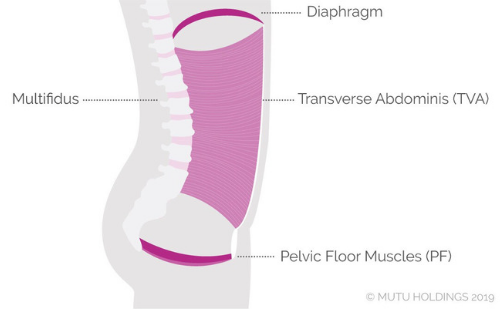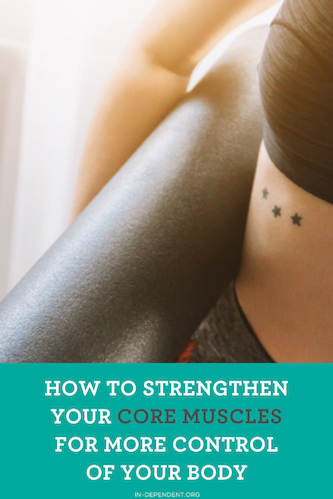Becoming familiar with the system of core muscles and learning how to use them properly is important for all female military spouses, whether you’re on the journey of motherhood, you love to work out, or you need to safely move boxes around during a PCS. Your core system can help with the pushing phase of delivering a baby, but these muscles are also used in every movement you make, big or small. When you tune in to these muscles and their functions, you will be able to move in a strong, pain-free way.
First, I’ll introduce you to the muscles that make up your core. It’s more than just your abs! Then, we’ll look more specifically at the pelvic floor and transverse abdominis, because these are the powerhouse muscles that, when properly trained, can help you gain complete control of your body. Finally, I’ll give you a simple breathing exercise to help you put your knowledge and muscles to use.
THE CORE SYSTEM
Your core system of muscles is made up of your:
· diaphragm
· pelvic floor
· transverse abdominis muscles (and other ab muscles to include rectus abdominis and obliques)
· multidifus (spine stabilizers)
Any woman can suffer with pelvic floor and core dysfunction, with symptoms like urinary/bowel issues, lower back pain, and discomfort during sexual intercourse. Getting this education about your body and then having tools to use when needed should be part of every woman’s journey. This area of women’s health continues to be ignored and women are often suffering in silence. We often don’t know how to ask for help, or even where to go to seek it. We have let these topics and conversations become taboo over the generations.
Becoming familiar with your pelvic floor and transversus abdominis muscles and then learning how to use them properly is a very important tool. Let’s get started.
PELVIC FLOOR
Location: the floor of the pelvis works like a hammock and attaches from the pubic bone all the way to the coccyx (tailbone).
Functions: for women, the pelvic floor is responsible for keeping organs (bladder, uterus, and bowel) in place and in an upright position, urinary and fecal control, and sexual function.
How to find it: my favorite cue is to imagine that you are drinking a smoothie with a straw through your vagina. Feeling anus lifting in the back is important too during these engagements. Remember the location is from the front (pubic bone) all the way to the back (tailbone).
TRANSVERSE ABDOMINIS
Location: deepest core muscle located underneath the rectus abdominis (six-pack muscle) running horizontally across the abdomen.
Functions: provides stability for the back and pelvis. Acts like a corset keeping core strong. This is very helpful if you suffer with symptoms due to diastasis recti. This muscle also protects the bladder from the front and strengthening it can help with incontinence and leaking.
How to find it: my favorite cue for this is to imagine you are going to bring your belly button to your heart—drawing up rather than sucking in. The great thing about this muscle is that you can feel it in action. Find your hip bones and place your middle and index fingers on them. Now move your fingers an inch (towards belly button) and an inch down. This is where you will feel that muscle fire when engaging correctly.
Learning about the pelvic floor and the transverse abdominis is a huge piece to the puzzle. Now you can put them to use in a simple breathing exercise. Once you master this technique, you can incorporate into everything you do—from yoga to CrossFit and everything in between.
BREATHING EXERCISE
Find a relaxing space, dim the lights, and play some relaxing music. You can do this sitting up or lying down. I recommend lying down to start because gravity is your friend when dealing with the pelvic floor in a supine position.
-
Lie down and get comfortable with your feet flat on your mat.
-
Place your fingers on your hip bones to locate transverse abdominis engagement.
-
Make sure your pelvis is in neutral with your back flat against the mat and your ribs relaxed.
-
Take a few deep breaths.
-
Inhale—let your belly rise (imagine a balloon filling in your belly).
-
Exhale and engage. Think of the cues mentioned above for the pelvic floor and transverse abdominis. Can you feel your pelvic floor in the back toward your anus? Can you feel the transverse abdominus under your fingertips?
-
Practice this breathing technique for 10 whole breaths.
This may feel very overwhelming and that’s okay! With practice, it will become easier. Most of us have never been taught this technique before or are even familiar with these muscles. Remember a few things as you are practicing this new technique. Inhale and relax, exhale and engage. Your core works together as a system. When the transverse abdominis engages, the pelvic floor should automatically fire as well. This may not happen initially, but with time you should feel a difference. These movements may feel very choppy at first, but eventually they should become more fluid and relaxed. Start simply with lying on the floor. Once you master this technique, try adding it to other movements such as squatting or lifting something like your baby or moving boxes.
Tricare covers women’s health physical therapy and I highly recommend for women to see a specialist if they can. All you need is a referral from your primary care manager.
To learn more about my women’s health mission and the symptoms I dealt with before finally receiving help, check out my previous post, 4 Disturbing Statistics You Need to Know About Pelvic Floor Health. You can also visit my blog and download my PDF, “10 Things Your Doctor Didn’t Tell You.” Please also feel free to email me with questions. The suffering and the silence around this area of our health stops here! The answer can be something as simple as education or tools. That is what I am here to do. Please feel free to reach out to me and ask me anything. If I don’t have the answer, I promise to have a resource for you.
ABOUT ASHLEY
Ashley Gammon is the community manager for M.O.M.S. and the PR executive for MUTU USA. She has made it her mission to bring awareness of pelvic floor and core health to military spouses and female service members across the globe. Her personal journey with MUTU and healing her postpartum body inspired her to bring awareness to military communities. Ashley and her husband have three girls all named after presidents, Mckinley, Madison, and Monroe. Ashley and her family reside in Michigan in their “forever” home after retiring from the Army after 20 years in October 2019.
CONNECT WITH ASHLEY
Facebook | Instagram | Website





